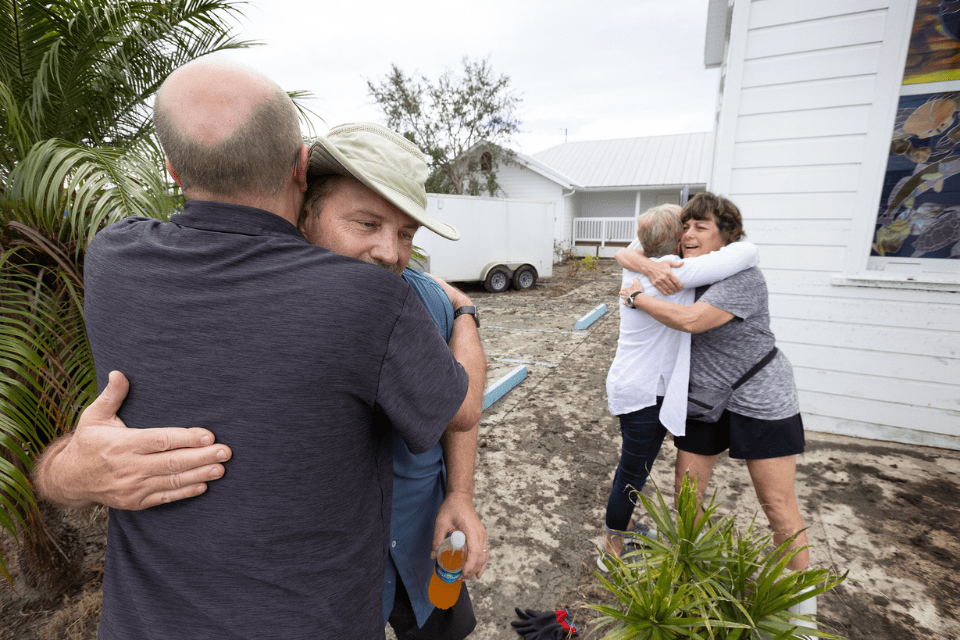In this op-ed, Audra Hudson Stone and Jacob Stone ask us to listen to the cries we hear following natural disasters like the recent hurricanes and do our part to practice resurrection.
AUDRA HUDSON STONE
JACOB STONE
Co-Conveners, Michigan Conference Environmental Justice Task Force
From noon until three in the afternoon the whole earth was dark. At about three Jesus cried out with a loud shout, “Eli, Eli, lama sabachthani,” which means, “My God, my God, why have you left me?” . . . Again, Jesus cried out with a loud shout. Then he died. Look, the curtain of the sanctuary was torn in two from top to bottom. The earth shook, the rocks split . . . (Matthew 27:45-46; 50-51, Common English Bible).
For most of earth’s history, natural disasters have been just that — natural. The land shows the scars of ancient earthquakes and the ripples of ancient floods. But, in recent centuries, since the industrial revolution, these landscapes and life-changing events have become increasingly unnatural.
Human-driven global temperature rise, habitat destruction, and resource exploitation have, together, contributed to more devastating disasters and extreme weather events.
Water-related disasters, in particular, have intensified due to human activity. Hundred-year rainfall events are now occurring in some places as frequently as every five to ten years. Some 23.5 million properties in the United States are at risk for flooding in the next 30 years. And, since the 1980s, hurricane strength, intensification, and incidence have increased yearly.
This was glaringly evident in the last two months when hurricanes Helene and Milton rocked the southern United States, damaging hundreds of communities and taking the lives of over 250 people in the span of just two weeks. Preliminary reports estimate that these storms will join the ranks of hurricanes Katrina, Harvey, and Sandy, costing over $50 billion in damages each.
These water-related disasters are symptoms of a growing problem. The earth is responding to the harm humans have inflicted.
However, the Gospel of Matthew reminds us that this response is not new. Like the floods and storms of our contemporary moment, the earth shook and the sky darkened when humans dealt death to Jesus. The land had a physical response to the harm wrought by those greedy for power and control.
Jesus, like many frontline communities in the climate crisis, was a victim of empire — a system that prioritizes the few over the many. His vision of justice and mercy and his priority on the marginalized threatened this prevailing order. Jesus’ death was an attempt to silence a new, more equitable power structure. He was killed to maintain the greed, power, and control of the status quo.
When Jesus cried out for a final time on the cross, the earth responded in kind. It cried, too, for the continued death-dealing of empire — for the continued harm its patterns of injustice and greed would cause. The rocks split, the sky turned black, and the earth shook in grief and protest.
As Christians, we should not look away from these holy stories that remind us of the consequences of greed and an outsized desire for power and control. Instead, and especially in the wake of catastrophes like the Helene and Milton hurricanes, we must pay attention to the cries of the earth and the cries of the marginalized, who are disproportionately impacted by climate crisis.
But we should not also forget the end of this story. We must remember that death is not the end for Jesus or us. We remember that God’s love, justice, and mercy prevail. Resurrection signals the reality that healing and wholeness are possible for the community of creation.
And in his resurrected body, Jesus invites us to be a part of this work. Jesus, in the words of Wendell Berry, invites us to “practice resurrection,” actively bringing about justice, mercy, and new life in the midst of harm and death.
And the good news is that signs of resurrection are already among us.
In the wake of Helene and Milton, first responders, utility workers, and charitable organizations nationwide have joined local residents in supporting relief work. Stories have emerged of everyday people giving their time and resources to clear roads, form emergency response centers, and provide vital necessities amidst the devastation.
Our United Methodist Church has sent meals, money, and prayers, and disaster response teams have gathered to begin the long work of recovery.
Houses are being repaired and rebuilt. Debris is being removed, and lives are being reassembled.
The storms have left indelible scars on the land and on lives. There is still much deeper work to do to change the systems of harm that have made these disasters so frequent and intense. But, healing has begun with collective action and the work of practicing resurrection.
In this age of climate crisis, we must take Jesus’ invitation to resurrection. Our earth is crying out, responding to how our actions and collective greed deal death.
But we remember that death does not have the final word. Repentance and transformation are possible. We must practice resurrection.
Here are two ways you can respond today in good faith:
-
- Help support hurricane recovery efforts by making a gift, serving, or learning more through the United Methodist Committee on Relief (UMCOR) and other Michigan Conference disaster ministry partners. Read this article to learn more.
- Learn more about faith-based environmental justice and ongoing efforts for change by connecting with The United Methodist Church’s General Board of Church and Society and the Michigan Conference’s Environmental Justice Task Force. Read more about this new initiative here in Michigan, and contact us to get the Zoom link for our regular meetings or to inquire further. Email us at environmentaljusticemiumc@gmail.com.
Last Updated on November 12, 2024

